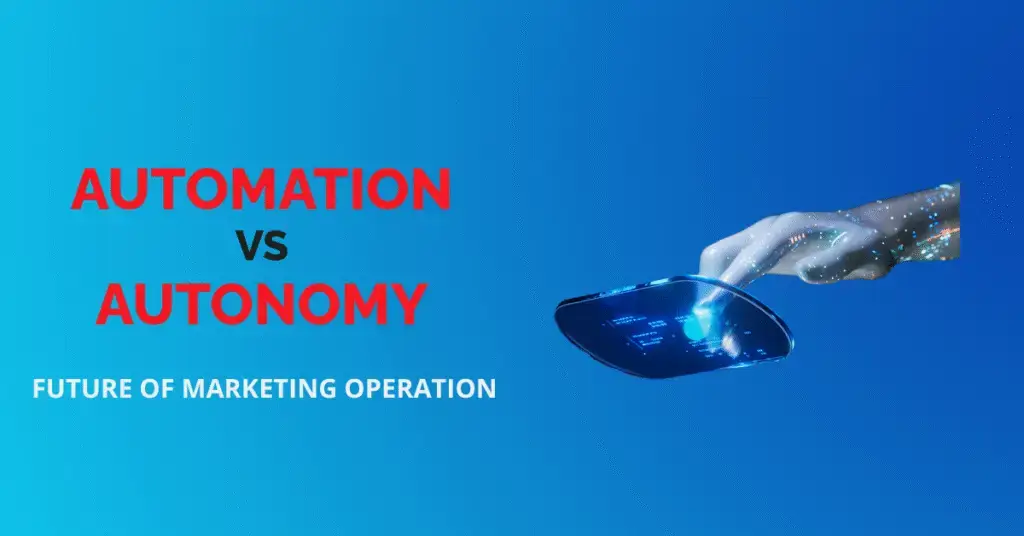
Automation vs Autonomy. What’s the Future?
For years, marketing operations have chased the promise of automation: faster workflows, fewer errors, and repeatable processes. Automated email triggers, CRM updates, and scheduled reports have been the backbone of modern marketing teams. Yet, as markets evolve at breakneck speed, a new reality is clear: automation alone isn’t enough.
While automation executes rules, it can’t think. It doesn’t adapt to sudden compliance changes, shifting buyer behavior, or market disruptions without manual intervention. To stay competitive in a world where data changes by the hour, marketing operations must evolve beyond rule-based efficiency into autonomy, where systems learn, adapt, and self-optimize with minimal human oversight.
This is the shift from automation vs autonomy, and it will define the next era of marketing performance.
Automation vs Autonomy: What’s the Difference?
Automation is rule-based. It follows predefined instructions: send an email when a lead fills out a form, trigger a nurture sequence, update a record. This approach is efficient but static, and it often collapses under market complexity.
Autonomy, by contrast, is adaptive and self-learning. Leveraging AI in marketing strategy, autonomous systems can:
- Analyze performance and adjust campaigns without manual rewrites
- Refine audience segments as behavior changes in real time
- Recommend next-best actions—or even execute them—without waiting for team intervention
For example, platforms like Oracle Eloqua or Adobe Marketo Engage can move beyond traditional rule-based triggers by integrating with AI layers that monitor performance patterns and initiate automated adjustments.
In short, automation repeats, autonomy evolves. In an era where B2B buying cycles are long, privacy rules are tight, and channels change rapidly, the ability to adapt instantly is the new competitive edge.
Why Rigid Automation Is Holding Teams Back
Most marketing teams have reached automation saturation. Adding more workflows or triggers brings only marginal gains. Common pain points include:
- Slow responses to market shifts – A new regional privacy law or platform update often requires manual workflow reconfiguration.
- Siloed data and disconnected tools – Automation can’t orchestrate across fragmented Martech stacks, leaving insights untapped.
- Lost creative bandwidth – Teams spend hours maintaining automations instead of driving strategy or innovation.
Gartner reports that marketers use only 33% of their martech stack’s functionality—a staggering underutilization that drags on strategic agility and underscores the limitations of traditional automation.
This is especially true in legacy deployments of tools like Eloqua and Marketo, where over-reliance on rigid workflows has made agility difficult. Without augmentation through AI and real-time data integration, these platforms struggle to deliver timely, context-aware experiences.
How AI Is Powering Autonomous Marketing Operations
The rise of AI in marketing strategy is the catalyst behind true autonomy in marketing operations. Today’s advanced platforms like Salesforce, Adobe, and GPT-powered systems don’t just automate tasks; they interpret data, learn from outcomes, and adjust strategy on the fly.
Rather than relying on static workflows, autonomous systems reshape operations through continuous feedback loops and real-time optimization. Here’s how:
- Real-Time Segmentation – Machine learning models automatically refine audience segments as behavior shifts, ensuring targeting stays accurate without constant manual intervention.
- Dynamic Journey Mapping – AI adapts each customer’s journey in real time, adjusting touchpoints, messaging, and timing based on engagement signals and intent—no need for pre-scripted flows.
- Self-Optimizing Campaigns – Content, channels, and delivery timing evolve automatically based on performance data, allowing campaigns to improve continuously without human input.
This shift unlocks decision agility; the ability to respond to new data immediately, not after weeks of analysis or manual reconfiguration. Marketing teams move from firefighting workflows to strategizing for growth, with AI acting as a real-time optimization engine.
Shifting from Automation to Autonomy: Where to Start
Transitioning to autonomous marketing operations isn’t about replacing your team with AI. It’s about freeing them from repetitive oversight so they can focus on high-value strategy.
Here’s how to start:
- Audit Your Current Workflows – Identify where rules-based automation creates bottlenecks or requires constant human intervention.
- Invest in Adaptive AI Tools – Choose platforms that learn and self-optimize—from segmentation to campaign timing.
- Unify Data Across Your Martech Stack – Connected data fuels autonomous decisions. Break silos between CRM, email, and analytics platforms.
- Redefine Team Roles – Shift talent from “workflow maintenance” to insight analysis and creative innovation.
- Foster a Learning Culture – Encourage experimentation and trust in AI-driven insights to build confidence in autonomy.
When implemented correctly, existing automation platforms like Marketo or Eloqua can serve as strong foundations; especially when paired with AI engines that enable dynamic content assembly, real-time prioritization, and predictive orchestration.
The Future: Decision Agility as a Competitive Advantage
Markets are accelerating, privacy laws are tightening, and customer expectations are rising. Incremental automation will no longer differentiate marketing teams.
The organizations that win will:
- Embrace decision agility through autonomous systems
- Operate on real-time learning and self-optimization
- Free their teams to focus on creative strategy, not workflow firefighting
Autonomy doesn’t replace human marketers; it elevates them. By letting machines handle adaptation, your marketing ops can finally think forward instead of chasing fixes. The next evolution of marketing operations isn’t just about doing things faster; it’s about doing the right things, automatically.





